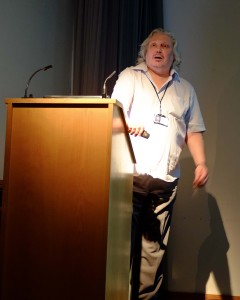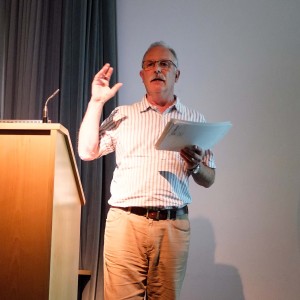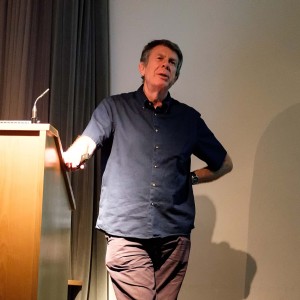June 9, 2014
Members’ Talks
Brian Blake, Chris Mann and Mike Dryland
Report by: Mike Meynell
One of the great pleasures of being a member of the Flamsteed Astronomy Society is the opportunity to chat to other members of the society about an incredibly wide range of topics. The knowledge of our membership never ceases to amaze me and has again been demonstrated by the quality of debate on our new online discussion forums.
The most visible aspect of this knowledge is our annual “members’ talks” evening, traditionally the last lecture of the Flamsteed season. At these events, we open the floor to Flamsteed members to give a talk about a topic of their choice, the only proviso being that the talk relates to astronomy (we are, after all, an astronomy society… though I’m quite certain that we could find members to talk about pretty much any topic you could think of!).
Our members’ talks lecture for the 2013/14 certainly didn’t disappoint, with three quality presentations.
Under Brazilian Skies – an Astronomers Experience in N.E. Brazil – by Brian Blake
First up, we had Brian Blake, who gave us a talk about his recent trip to Brazil. Brian visited the north-east of Brazil, around the area of Recife, and briefly gave us a history of astronomy in Brazil, first talking about Dom Pedro II, the last emperor of Brazil. He seemed to be a very interesting character, a great lover of science and culture, he insisted that Brazilian children had an education that was science based and appears to have had the respect of many European scholars.
Dom Pedro II was also a photographer and an astronomer and took many hundreds of astronomical plates throughout his life. He also had an astronomical observatory constructed (the Torre Malakoff Observatory), where he took photographs of the night sky.
Brian then talked to us about his visit to the city of Olinda. Olinda also has an observatory, although this is no longer used for research and has become more of a tourist attraction. Brian met up with the local astronomy society in Recife – the Sociedade Astronomica Do Recife, where he did a talk about the history of the Royal Observatory in Greenwich and the Flamsteed Astronomy Society. One striking feature of the Recife Astronomy Society is the age of its members… they do have a very young membership, which is hugely encouraging for the future of astronomy in Brazil. Brian found himself to be the oldest person in the room!
Unfortunately, weather conditions meant that Brian was unable to do very much observing, but this didn’t dampen either his enthusiasm or the enthusiasm of the amateur astronomers that he met. He urged Flamsteed members to get in touch with the Recife Astronomy Society, at contato@sociedadeastronomica.com.br . It would be great to forge some links with this society and hopefully welcome them to Greenwich one day.
Brazilian astronomy is certainly going from strength to strength, with plans to join the European Southern Observatory being debated at present. A very prescient time to talk about Brazilian astronomy, and we thank Brian for a most enlightening presentation.
Variable Stars – What They Are and How to Observe Them by Chris Mann
The next presentation of the evening came from Chris Mann, who came to talk about variable stars. Chris has a passion for variable star observation and is a regular contributor to the BAA Variable Stars Section.
Chris first described the rather peculiar nomenclature of variable stars. Bayer first classified the stars according to their brightness, with the Greek alphabet used for the 24 brightest stars and then Latin letters used thereafter. The highest letter used was a “Q”, so the first variable stars named were designated with letters R through Z. Clearly this only gave the possibility of naming 9 variable stars within a constellation. Once these letters had run out, astronomers doubled-up the letters, so that RR-ZZ could be used, giving a further 45 combinations. Of course, this was not enough either! So astronomers returned to the beginning of the alphabet to use AA-QZ (not JJ-JZ, for some, unknown, reason!), giving a further 280 combinations. This gives 334 possible combinations in total. However, this still wasn’t enough! Now astronomers use the prefix “V”, along with a number (starting at 335) to identify variable stars.
On it’s own, this seems a worthwhile reason to study variable stars. As Chris said, you couldn’t make it up!
Chris went on to discuss what makes a star vary in brightness. Essentially, there are two types of variable star; those that vary in brightness due to an intrinsic reason (e.g. pulsating, eruptive or cataclysmic stars) and those that vary in brightness for an extrinsic reason (e.g. eclipsing binary stars or rotating spotty stars).
More than half of stars are binary systems. If the orbital plane is oriented such that one object crosses the disc of the other object, then there is a variation in brightness. An example of this is Algol (Beta Persei). The light curves from these systems will differ depending on the type of binary system, whether the stars are completely isolated from each other, or if the stars have some sort of contact or exchange of material.
Some stars have a non-uniform surface brightness, resulting from star spots, mass outflow or even shape distortion. Again, these stars will show variable brightness as they rotate.
Eruptive variables are those with flares occurring in their chromospheres, along with mass ejections and other stellar-wind phenomena. Ejected matter can cause brightness drops. There are many types of eruptive variable, such as the young T-Tauri stars, which are pre main sequence stars with powerful stellar winds.
Pulsating variables are stars that swell and shrink, which in turn affects their brightness. Again, there are several types of pulsating variable star: Cepheid variables are perhaps the best known. With Cepheid variables, there is a strong relationship between the luminosity and the rotation period, enabling astronomers to determine to distances to other galaxies. Famously, Edwin Hubble used Cepheid variables in the Andromeda Galaxy to show that variables were not members of the Milky Way and thereby settling the “Island Universe” debate.
Finally, cataclysmic variable are either explosive or nova-like variables. This is usually due to thermonuclear runaway on either the star surface or on an accretion disc. Novae are a product of accretion from one star of a binary system onto the other star (usually a white dwarf or neutron star). Supernovae, of course, are due to gigantic stellar explosions of a star.
Chris went on to describe the process for observing variable stars. It is done by identifying the relevant star from a star chart and then comparing the brightness to the brightness of other stars in the field of view that have a known brightness. This data is then sent to the BAA, who have a database of observations dating back to 1862.
So, why observe variable stars? Chris explained that variable stars must be observed over decades in order to determine their long-time behaviour. Professional astronomers do not have the available time or the telescope access needed to gather data on the brightness changes of thousands of variable stars. Therefore, the amateur community make a real and highly useful contribution to science by observing variable stars and submitting their observations.
Variable stars play a crucial role in our understanding of the universe. We have already read how Cepheid variables changed our understanding of the universe. Mira variables may give us a glimpse of the evolution of our own star, the Sun. And, of course, the search for extra-terrestrial life may also be helped by variable star observation. Transiting extrasolar planets also cause a variation in the brightness of the star. Chris urged Flamsteed members to consider starting variable star observation, and kindly offered to mentor any member who wanted to get involved.
Thanks to Chris for a superb talk.
What did George Airy ever do for us? by Mike Dryland
Our final talk of the evening came from Mike Dryland. Mike is, of course, the former vice-chair of the society and now the main organiser of the Flamsteed History of Astronomy group. Mike came to talk about George Biddell Airy, the seventh Astronomer Royal.
Airy was born in 1801. He showed a prodigious talent for mathematics and graduated as senior wrangler at Cambridge in 1823 and became the Lucasian Chair of Mathematics in 1826, before switching to astronomy and becoming the Plumian professor of astronomy in 1828.
One of his main achievements of this era was providing a mathematical description of the diffraction pattern created by lens for a point source of light – a phenomenon now known as the Airy disk. His interest in optics, and the fact that he suffered from astigmatism, caused him to find a method for correcting this problem using cylindrical lenses. He strongly encouraged the building of the Northumberland Telescope in Cambridge. The design of the telescope mount will be familiar to all visitors to the Great Equatorial Telescope at the Royal Observatory.
In 1835, he became the seventh Astronomer Royal, a post in which he remained for the next 46 years until his retirement in 1881. In this post, his incredible organisational skills came to the fore. It’s here that two of the most popular stories about George Airy are told: firstly that he would date and sign any blotting paper that he used and file it away for future reference and secondly that he was found in an observatory store room labeling empty boxes as ‘empty’! However, his work on procedures at the observatory would be his lasting legacy, meaning that many of the tasks could be de-skilled and performed by human ‘computers‘. In addition, the expansion of the sunspot record was down to Airy as was the installation of the Airy Transit Circle that led to Greenwich becoming the Prime Meridian of the World in 1884.
It was Airy who presided over the adoption of standard time in Britain. Prior to this, different parts of the country kept their own local time. This, of course, changed completely after the introduction of railways, as they needed to use standard time in all parts of the country so that railway timetables could be set. Airy adopted electro-galvanic clocks so that time could be communicated across the country via telegraph.
As Airy’s reputation grew, he effectively became the chief consulting scientist to the government. As a result, he became involved in trying to solve many of the scientific problems of the day. These included:
- Finding a solution to the problem of using compasses in iron ships;
- Being one of the members of the government commission which set the standard railway track gauge for Great Britain;
- Acting as project manager for the installation of the Westminster Great Clock (colloquially known as “Big Ben”, though this is actually the name of the bell). This included a telegraphic link to the Greenwich Observatory;
- Designing an experiment to weigh the Earth using a pendulum (though this proved to be rather inaccurate).
There were some setbacks as well. When Neptune was discovered by the Berlin Observatory, using calculations from a French mathematician, there were many who questioned why the British had not made this discovery. As Astronomer Royal, Airy took a great deal of criticism for this from the press. However, he used this bad publicity to lobby for the installation of a large refracting telescope at Greenwich. This he eventually achieved, with the building of the Great Equatorial Building and the installation of the 12¾ inch Merz telescope in 1859. Later, this telescope was replaced by the Great Equatorial Telescope in 1893, although the 28-inch uses the same English-equatorial mount that Airy had installed.
Airy retired in 1881 and died in 1892 at the age of 90.
Thank you to Mike for another superb talk to the society.
Conclusion
So, that concluded the 2013/14 lecture programme. Plans for the 2014/15 season have already been finalised, with some very interesting lectures in place.
This was the 58th Flamsteed event that we’ve organised this season, which is a new record. By the end of the season, we are likely to have organised about 70 events. This extraordinary number of events would not be possible without the dedication of our volunteers, especially those on the Flamsteed committee, so my thanks to everyone who have helped to make this season such a success.
The first lecture of the new season will also be the occasion of our 15th Annual General Meeting. As usual we will be looking for nominations to the committee. As we seem to be running an ever-increasing number of events, if you’d like to get involved in the helping to run the society, please let us know!
Posted under: Flamsteed, Flamsteed Lecture, Meeting Report




You must be logged in to post a comment.